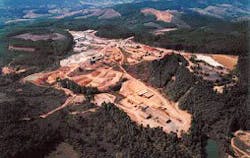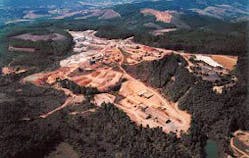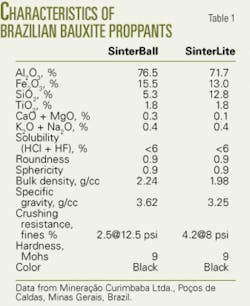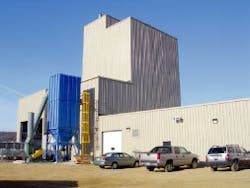Demand for manufactured proppants is growing, fueling the construction of new production facilities around the world.
Analysts from the Freedonia Group say that the market for well-stimulation materials in the US will increase 7.7%/year through 2008. The US market was valued at $981 million in 2004, but the analysts see this increasing to $1.4 billion by 2008. Proppants will represent about 39% of the well-stimulation market in 2008, followed by base fluid materials (32%), and additives (27%).
The analysts say that “proppants will remain the largest segment and grow the fastest” at 9.5%/year, to reach $550 million by 2008. They expect that foaming agents and cross-linking agents will also do well.1
Freedonia analysts say that the southern region of the US (Gulf of Mexico, Louisiana, Texas, New Mexico) represents the largest market for well-stimulation materials, followed by the western region (California, Utah, Wyoming, Colorado) because of the prevalence of coalbed methane plays and tight sands.
Many different natural and synthetic materials have been used downhole to “prop” open hydraulically created fractures in oil and gas wells and increase the productivity. Raw sand and coated sand proppants are most common, but demand is growing for ceramic proppants made of clay or sintered bauxite spheres. Even walnut shells have been used.
Typically, a well might require 100,000-500,000 lb of proppant for a single hydraulic fracture treatment. Natural sand is often rough, with sharp edges, and compacts more than round, smooth proppants under pressure. Spherical proppants allow more flow, resulting in improved reservoir productivity. Increases in the proppant market are driven largely by the demand for the greater fracture flow capacities provided by resin coated sands and ceramic proppants.
According to Robert Aronen, writing for the online market newsletter The Motley Fool in September 2005, sand proppants comprise 83% of the total proppant market.2 He said that ceramic proppants represent 17% of the proppants used worldwide but are increasing in market share because of “their uniform size and increased strength, which improves production rates, easily justifying a higher price compared to sand.”
Demand for ceramics
Hydraulic proppant fracturing began in 1947, says Detlef Mader in his text on hydraulic fracturing, but many innovations have improved the options in the last 60 years.3
Among the materials manufactured today are clay-based ceramic and sintered bauxite-based ceramic proppants. Ceramic proppants are sand-sized spherical ceramic beads that are fired at a high temperature and are able to maintain their integrity under very high pressure. They can be coated with phenolic resins to suit different reservoir conditions.
According to Lehman Brothers analysts Lisa Hackman and James Crandell, there are “high levels of unmet demand worldwide” for ceramic proppants.4
Proppant manufacturers have been hit with higher-than-forecast natural gas prices, and those companies that have not hedged gas futures find uncomfortable economic circumstances.
The three main suppliers of ceramic proppants worldwide are US-based Carbo Ceramics Inc., US-French Saint-Gobain Proppants, and Brazil’s Mineração Curimbaba Ltda.
Carbo Ceramics
Irving, Tex.-based Carbo Ceramics Inc. supplies proppants internationally and considers itself a leading manufacturer of ceramic proppants and supplier of fracture diagnostic services for hydraulic fracturing of oil and gas wells.5
According to Rich Duprey (Motley Fool, December 2005), Carbo Ceramics has 50% of the worldwide market for ceramic proppants.6 But the company appears to be losing market share. In July 2004, Carbo had 56% of the market.7
The company took a hit in November 2005 when it began paying market rates for natural gas, increasing expenditures 65% over fourth-quarter 2004. It has hedged 50% of its 2006 natural gas requirement. Carbo has been operating at full capacity for the last 2 years and may require some maintenance downtime in 2006. In fourth-quarter 2005, Carbo Ceramics shipped about 190 million lb of proppants at an average price of $0.298/lb, down 1% from $0.301/lb in the third quarter.
Stephen D. Simpson (Motley Fool, February 2006) said that Carbo sold 6% less proppants in the last quarter, even though prices were up 7% on average.8
Bauxite is a primary raw material in the manufacture of high-strength proppants and analysts say that Carbo’s bauxite supply was temporarily interrupted in fourth-quarter 2005. This caused operators and drillers to switch to lower-priced lightweight ceramic proppants made from calcinated kaolin.
Carbo operates manufacturing facilities in New Iberia, La.; Eufaula, Ala.; McIntyre, Ga. (McIntyre I, two manufacturing lines); and Luoyang, China.
The company began operating a new facility in Toomsboro, Ga., in January 2006 (McIntyre II, four lines planned). The $62-million Georgia plant has 250 million lb capacity. Carbo is also building a 100-million-lb capacity plant in Kopeysk, Russia, about 1,000 miles east of Moscow. It will be completed by late 2006 at a cost of $32 million.
Carbo Ceramics’ products are currently stored in North America, Europe, and China; 80% of Carbo’s product is distributed to the three largest oil field service companies: Halliburton Corp., Schlumberger Ltd., and BJ Services Co.
In 2002, Carbo purchased Pinnacle Technologies Inc., specializing in fracture mapping tools. Aronen characterizes Pinnacle’s products as the “most widely used fracture simulation software in the world.” In January, Carbo announced that Pinnacle’s sales rose to $7.5 million in fourth-quarter 2005, from $6.1 million/year earlier.
Although hydraulic fracture software is used in the frac design for very few wells, the business segment has a large growth potential, analysts suggest.
Saint-Gobain Proppants
The world’s second-largest producer of ceramic proppants is Fort Smith, Ark.-based Saint-Gobain Proppants, owned by Paris-based Compagnie de Saint-Gobain.9 In July 2004, Motley Fool writer Rich Duprey said that the company had a 22% market share.10
In 1973, Norton Co. developed spherical sintered bauxite proppant to replace conventional sand proppant for Exxon Corp. Norton began to produce the sintered bauxite commercially in 1977 and opened a manufacturing facility in Fort Smith in 1979. In 1984, Norton Co. joined with Aluminum Co. of America (Alcoa) to operate under the name Norton-Alcoa Proppants and tripled production.
In 1989, the Saint-Gobain Corp. acquired Norton Co. In 2001, Alcoa sold its 50% share to Saint-Gobain, and Norton-Alcoa Proppants became Norton Proppants Inc. (OGJ Online, Apr. 5, 2001). In October 2004, Norton Proppants changed its name to Saint-Gobain Proppants.
In late 2004, Saint-Gobain acquired a manufacturing plant in Guanghan, China, to serve growing markets for proppants in China, Russia, and Southeast Asia. The company upgraded the facility in early 2005 to produce 10,000 tonnes/year of proppant. It is also building a 25,000-tonne plant on the same site that it expects to be finished in early 2006.
Saint-Gobain says it has a new 50,000-tonne facility under construction in Venezuela that it expects to come on line this year; it also plans to increase the capacity. In the US, Saint-Gobain expanded the Fort Smith facility by 40,000 tonnes in 2005.
The company produces both ceramic (Ultraprop; Interprop; Versaprop) and sintered bauxite proppants. Ultraprop is a high-strength proppant that does not follow a standard API sieve distribution. Interprop and Versaprop are intermediate strength proppants; Interprop is available in four sizes: 12/18, 16/30, 20/40, and 30/50 mesh. The Saint-Gobain sintered bauxite proppant is the strongest of all, says the company, and is available in three sizes: 16/30, 20/40, and 30/50 mesh.
Saint-Gobain says that median particle diameter (MPD) is the single most significant factor influencing conductivity. The MPD for 20/40 mesh is about 0.65 mm and about 0.95 mm for 16/30 mesh. The company offers a two-step PropSelect tool that uses a dimensionless conductivity factor to calculate the conductivity required to produce the desired effective fracture length and then suggests the five most cost-effective proppants for a particular set of reservoir characteristics, based on the minimum and maximum proppant-pack concentrations specified.
Mineração Curimbaba
Based in Poços de Caldas, southern Minas Gerais, Brazil, Mineração Curimbaba Ltda. produces about 10% of the world’s supply of ceramic proppants, specializing in high-grade bauxite.11 The company was established to produce potassium fertilizer in 1950 under the name Benedito Moreira Curimbaba and changed to Mineração Curimbaba in 1961 when it began to export bauxite ores for different markets.
The company says it has more than 200 million tons of bauxite reserves, in addition to potassium, limestone, quartz, and refractory clays. Poços de Caldas lies in the caldera of an extinct volcano on a plateau at 4,200 ft, and the company mines deposits in and around the rim of the crater (Fig. 1). Mineração Curimbaba says it revegetates land after mining and maintains a nursery with more than 125,000 plants of native species for that purpose.
Mineração Curimbaba has two product lines for the petroleum industry: SinterBall bauxite and SinterLite bauxite (Table 1). The two commercial proppants contain more than 60% alfa-alumina (Al2O3), the main component of technical grade alumina. Corundum is natural Al2O3; emery is an impure crystalline variety of Al2O3, also called aluminum oxide.12
SinterLite contains <15% mullite, 1-10% hematite, and <1% magnetite. SinterBall has 2% mullite, 1-15% hematite, and <2% magnetite.
Mullite (3Al2O3·2SiO2) is the only chemically stable intermediate phase in the SiO2-Al2O3 system. It is rarely found naturally (only on the Isle of Mull, off the west coast of Scotland), but it is synthesized in a variety of ways to make synthetic mullite ceramics. One method is by calcinating kyanite by heating to 3,000º F. Virginia’s Kyanite Mining Corp says that mullite has “outstanding hot load-bearing properties...is resistant to many corrosive environments” and is a key ingredient in many ceramic products.13
The high alumina content in bauxite proppants provides strength, chemical resistance, and thermal stability required for downhole environments. Higher alumina content produces a higher strength proppant, necessary in deeper wells where fractures are subject to higher closure stress.
Mineração Curimbaba’s proppants are manufactured in a continuous process and packaged in bulk bags containing 3,300 lb. Each bulk bag is tested according to API RP-60, the results for the lot are tabulated on a quality control certificate, and a copy of the certificate is affixed to the bulk bag containing that lot.
SinterBall bauxite is round sintered bauxite with high crushing strength. It was introduced in 1988 and is available in four sizes: 14/20, 16/30, 20/40, and 30/50.
SinterLite bauxite has medium crushing strength and was brought to market in 1999. It’s a low-density, less-expensive bauxite proppant used in high-temperature environments, often in place of lightweight and intermediate ceramic proppants. The company says it has high crush resistance, good chemical resistance, and thermal stability because of its high alumina, low silica content. It is available in four sizes (8/16, 12/20, 16/30, and 20/40) but it is not sold in the US.
According to Stockholm’s Raw Materials Group (RMG), Mineração Curimbaba is controlled and owned by Oxicur Ltda. and Alopar Participacoes e Comercio Ltda. RMG maintains 17 years of Curimbaba bauxite production data, 1987-2003.
According to Rosenberg, Tex.-based Sintex Minerals & Services Inc., the Curimbaba bauxite holdings represent the largest known deposit of high-grade bauxite in the world and Curimbaba is the largest supplier of bauxite proppant worldwide.
SinterBall bauxite has been used in thousands of hydraulic fracturing jobs in North America, South America, Europe, Asia, Africa, and Australia. Sintex says that more than 500 million lb have been shipped to North America.
Sand, RC proppants
With 83% of the total proppant market, sand proppants remain financially important.
Fresno, Tex.-based Santrol was among the first companies to design and run phenolic formaldehyde resin-coated proppants. The company was formed in 1976 and taken over by Fairmount Minerals in 1991.
Resin coated (RC) proppants can be curable or tempered (precured). Tempered resin proppants appeared in 1981. Dual-layered (inner layer of tempered resin, outer layer of partially cured resin) came to the market in 1984.
Resin is used to coat silica sand, ceramics, or glass beads, and RC proppants can be used in oil or water-based drilling fluids. The resin coating bonds the proppant grains in the fractures and reduces proppant flowback. If down hole temperatures are too low to activate resin bonding thermally, liquid chemical activators can be added.
Santrol manufactures resin-coated ceramic proppants in Texas and has an annual capacity of more than 20 million lb.
In 1995, Santrol joined with PV Sand AS in Denmark. Santrol Denmark’s facility provides resin-coated proppants to the North Sea, Europe, and the CIS/FSU.
One of the newest manufacturers of resin-coated sand proppants is Tulsa-based Atlas Resin Proppants LP.14 The company’s new manufacturing facility in Taylor, Wisc., was completed at yearend 2005 and has a capacity of more than 200 million lb/year (Fig.2). The plant location adjacent to the Badger Mining Corp. sand quarries provides ready access to highly spherical sands. Atlas produces several grades of resin-coated proppants: precured for enhanced fracture flow conductivity, and curable for proppant pack stabilization.
Badger Mining’s Taylor plant began production in 1979 and produces about 800,000 tons/year of high-quality industrial sand used predominantly for hydraulic fracturing and gravel packing. Badger Mining is a privately held, family-owned corporation with facilities in the US, Canada, and Poland.
Chardon, Ohio-based Fairmount Minerals Ltd. began with a silica sand mine in Wedron, Ill., in 1986. The Wedron sand is 450 million years old (Ordovician) and mined from the St. Peter formation. The plant’s capacity is more than 1 million tons/year of 20/40, 40/60, and 100 mesh grade sands.
Fairmount also produces sand from an underground mine near Maiden Rock, Wis. The company produces three grades of frac sand (20/40, 40/60, and 100 mesh) from the Cambrian age Jordan formation.
After screening, the sands are resin-coated at the Troy Grove, Ill., and Roff, Okla., plants, with a total capacity of more than 150,000 tons/year. The resin-coated sands are shipped in bulk, or in 3,000-lb bags, 4,000-lb bags, or 100-lb paper sacks.
Sand proppants are also supplied by:
• Connecticut-based Unimin Corp., founded in 1970, and now with operations in North America, South America, Scandinavia, and Australia.
• Cleveland, Ohio-based Oglebay Norton Co., which provides proppant sands through its Brady, Tex., subsidiary, Oglebay Norton Industrial Sands Inc. The company takes sand from an open quarry, washes, dries, screens, and separates it into size fractions before shipping to the company’s distribution center in Bakersfield.
Proppant manufacturing and supply is a fast-growing industry. As operators seek to increase production from existing wells, explore tight reservoirs, and drill deeper, they will increasingly turn to hydraulic fracturing and in particular, to high-strength manufactured proppants, fueling the market for well stimulation materials and services.✦
References
1. “Oil & Gas Well Stimulation Materials to 2008-Market Size, Market Share, Market Leaders, Demand Forecast and Sales,” Cleveland: The Freedonia Group Inc., Study No. 1801, October 2004.
2. Aronen, R., “CARBO Goes Deep,” The Motley Fool, Sept. 19, 2005.
3. Mader, D., Hydraulic Proppant Fracturing and Gravel Packing, Developments in Petroleum Science 26, Amsterdam: Elsevier, 1989.
4. Hackman, L.R., and Crandell, J.D., “CARBO Ceramics-Earnings Shortfall But Outlook Positive,” Lehman Bros. Equity Research, Feb. 6, 2006.
5. www.carboceramics.com
6. Duprey, R., “Heartache at Carbo Ceramic,” The Motley Fool, Dec. 5, 2005.
7. Duprey, R., “Carbo Ceramics’ Fractured Future,” The Motley Fool, Oct. 29, 2004.
8. Simpson, S.D. “Cracks in Carbo Ceramics Can Be Repaired,” The Motley Fool, Feb. 3, 2006.
9. www.nortonproppants.com/company.html
10. Duprey, R., “Carbo Ceramics Gushes Profits,” Duprey, R., July 22, 2004.
11. www.curimbaba.com.br
12. NIOSH Publication No. 2005-151: NIOSH Pocket Guide to Chemical Hazards, September 2005, www.cdc.gov/niosh/npg/npgd0021.html
13. www.kyanite.com/mullite.html.
14. www.atlasresinproppants.com.





